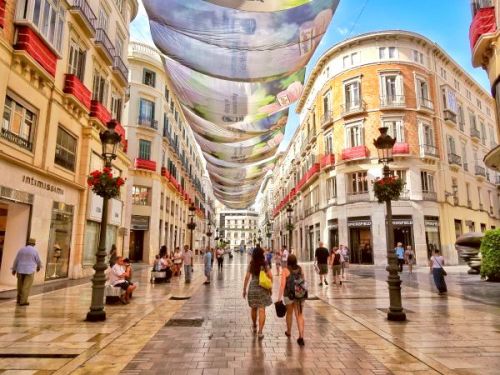 The long history of Malaga has been enriched by various different civilisations that passed by and left their traces in our unique lands.Malaga, with the name ‘Malaka’ (fish salting place), was founded by the Phoenicians about 800 BC., and was used as a commercial enclave, following the colonisation that had been initiated 1100 BC. by the foundation of Gadir (Cádiz). After 70 years of Greek domain, Malaga was dominated by the Carthaginians, but after the Punic Wars that finished in 202 B.C. with the Roman victory, Malaga fell under Roman domain, and was named Flavia Malacita, and further on converted into an important point of passage, as it was connected with other Roman centres on the Peninsula and harbours of the Mediterranean Sea. The Roman Theatre, at the bottom of the Arabian fortress 'Alcazaba', is from this epoch, and despite its small dimensions, is one of the most ancient in the entire Hispania.
The long history of Malaga has been enriched by various different civilisations that passed by and left their traces in our unique lands.Malaga, with the name ‘Malaka’ (fish salting place), was founded by the Phoenicians about 800 BC., and was used as a commercial enclave, following the colonisation that had been initiated 1100 BC. by the foundation of Gadir (Cádiz). After 70 years of Greek domain, Malaga was dominated by the Carthaginians, but after the Punic Wars that finished in 202 B.C. with the Roman victory, Malaga fell under Roman domain, and was named Flavia Malacita, and further on converted into an important point of passage, as it was connected with other Roman centres on the Peninsula and harbours of the Mediterranean Sea. The Roman Theatre, at the bottom of the Arabian fortress 'Alcazaba', is from this epoch, and despite its small dimensions, is one of the most ancient in the entire Hispania.
After the fall of the Roman Empire, Malaga was affected by large migrations and settlements of German tribes, in particular the Silinge vandals who introduced the Arian Credo from the Orient. At the beginning of the 8th Century, the decay of the Gothic monarchy began, and from the coast of North Africa, the Arabs invaded the Iberian Peninsula.
Malaga fell under their domain in 743. Malaga was converted into a flourishing town, surrounded by a wall with five huge gates. Numerous suburbs composed the town with a route across from east to west connecting the harbour and the Alcazaba with the interior district of the wall. The suburbs were occupied by Genoese merchants and Jews who settled down independently from the rest of the town. Abderramán III had the gate ‘La Puerta de Atarazanas’ constructed in 13th Century (which is the access to the Central Market nowadays). Though the first attempts of conquest took place in the 14th Century, it was not until near the end of 15th Century when the Catholic Kings achieved it.
Malaga was conquered on the 19th August 1487 (the last town to be conquered was Granada in 1492). Along with the conquest, religious communities were fundamental in urban growth, as they produced the integration of the surrounding suburbs. A big square was created for the first time, the main square, (today Constitution Square), and the convents of Victoria and Trinidad (Trinity) were founded. The 16th and 17th Centuries were characterized by the crisis that was provoked by the expulsion of the Moors who had converted to Christianity on one hand, and on the other by bad harvests, flooding caused by the overflowing of the river Guadalmedina, and by epidemics.
In the 17th Century, the harbour was constructed and later on it was extended. Although the works of the Cathedral started in 1528, they were not finished until the 18th Century, when Baroque was in an advanced state. In the same epoch, another extension of the harbour was carried out, and thus, the recuperation of the preceding centuries was reactivated.






